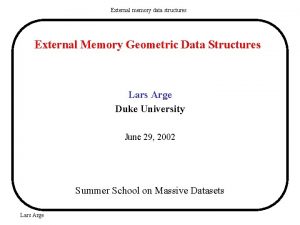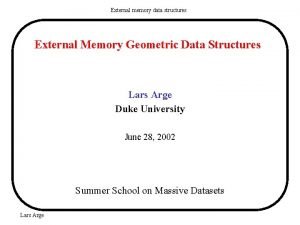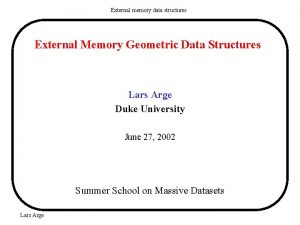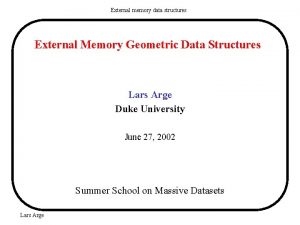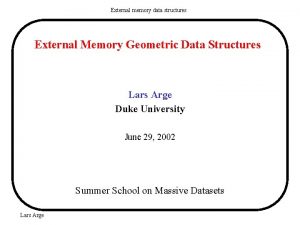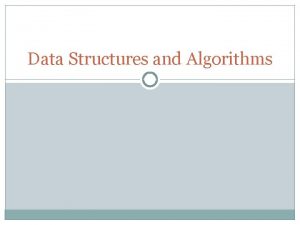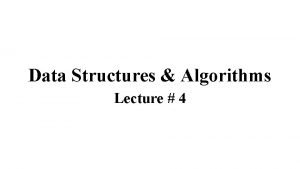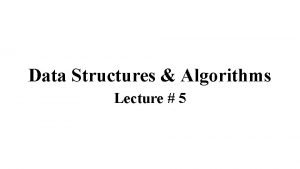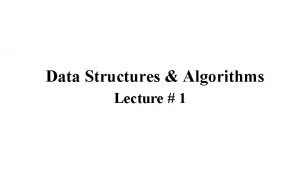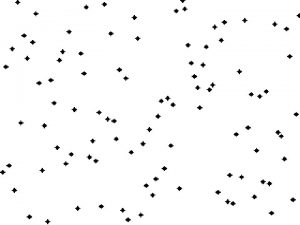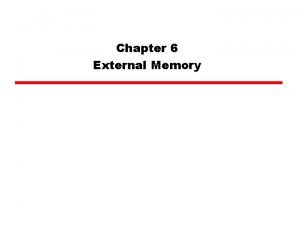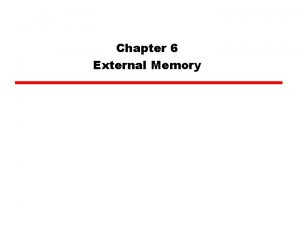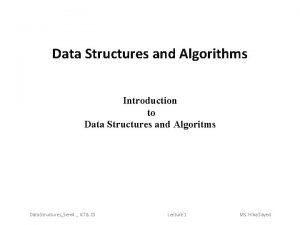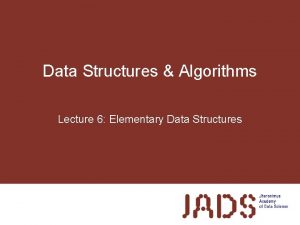External memory data structures External Memory Algorithms for























- Slides: 23

External memory data structures External Memory Algorithms for Geometric Problems Piotr Indyk (slides partially by Lars Arge and Jeff Vitter) Lars Arge

External memory data structures Today • 1 D data structure for searching in external memory – O(log N) I/O’s using standard data structures – Will show to reduce it to O(log BN) • 2 D problem: finding all intersections among a set of horizontal and vertical segments – O(N log N)-time in main memory – O(N log B N) I/O’s using B-trees – O(N/B * log M/B N) I/O’s using distribution sweeping • Another 2 D problem: off-line range queries – O(N/B * log M/B N) I/O’s, again using distribution sweeping Lars Arge 2

External memory data structures Searching in External Memory • Dictionary (or successor) data structure for 1 D data: – Maintains elements (e. g. , numbers) under insertions and deletions – Given a key K, reports the successor of K; i. e. , the smallest element which is greater or equal to K Lars Arge 3

External memory data structures Model D • Model as previously – N : Elements in structure – B : Elements per block – M : Elements in main memory Block I/O M P Lars Arge 4

External memory data structures Search Trees • Binary search tree: – Standard method for search among N elements – We assume elements in leaves – Search traces at least one root-leaf path Þ Search in Lars Arge time 5

External memory data structures (a, b)-tree (or B-tree) • T is an (a, b)-tree (a≥ 2 and b≥ 2 a-1) – All leaves on the same level (contain between a and b elements) – Except for the root, all nodes have degree between a and b – Root has degree between 2 and b (2, 4)-tree • (a, b)-tree uses linear space and has height Choosing a, b = each node/leaf stored in one disk block space and query Lars Arge 6

External memory data structures (a, b)-Tree Insert • Insert: Search and insert element in leaf v DO v has b+1 elements Split v: make nodes v’ and v’’ with and elements insert element (ref) in parent(v) (make new root if necessary) v=parent(v) • Insert touches Lars Arge v v’ v’’ nodes 7

External memory data structures (a, b)-Tree Delete • Delete: Search and delete element from leaf v DO v has a-1 children Fuse v with sibling v’: move children of v’ to v delete element (ref) from parent(v) (delete root if necessary) If v has >b (and ≤ a+b-1) children split v v=parent(v) • Delete touches Lars Arge v v nodes 8

External memory data structures B-trees • Used everywhere in databases • Typical depth is 3 or 4 • Top two levels kept in main memory – only 1 -2 I/O’s per element Lars Arge 9

External memory data structures Horizontal/Vertical Line Intersection • Given: a set of N horizontal and vertical line segments • Goal: find all H/V intersections • Assumption: all x and y coordinates of endpoints different Lars Arge 10

External memory data structures Main Memory Algorithm • Presort the points in y-order • Sweep the plane top down with a horizontal line • When reaching a V-segment, store its x value in a tree. When leaving it, delete the x value from the tree • Invariant: the balanced tree stores the V-segments hit by the sweep line • When reaching an H-segment, search (in the tree) for its endpoints, and report all values/segments in between • Total time is O(N log N + Z) Lars Arge 11

External memory data structures External Memory Issues • Can use B-tree as a search tree: O(N log B N) I/O’s • Still much worse than the O(N/B * log M/B N) sorting time…. Lars Arge 12

External memory data structures 1 D Version of the Intersection Problem • Given: a set of N 1 D horizontal and vertical line segments (i. e. , intervals and points on a line) • Goal: find all point/segment intersections • Assumption: all x coordinates of endpoints different Lars Arge 13

External memory data structures Interlude: External Stack • Stack: – Push – Pop • Can implement a stack in external memory using O(P/B) I/O’s per P operations – Always keep about B top elements in main memory – Perform disk access only when it is “earned” Lars Arge 14

External memory data structures Back to 1 D Intersection Problem • Will use fast stack and sorting implementations • Sort all points and intervals in x-order (of the left endpoint) • Iterate over consecutive (end)points p – If p is a left endpoint of I, add I to the stack S – If p is a point, pop all intervals I from stack S and push them on stack S’, while: * Eliminating all “dead” intervals * Reporting all “alive” intervals – Push the intervals back from S’ to S Lars Arge 15

External memory data structures Analysis • Sorting: O(N/B * log M/B N) I/O’s • Each interval is pushed/popped when: – An intersection is reported, or – Is eliminated as “dead” • Total stack operations: O(N+Z) • Total stack I/O’s: O( (N+Z)/B ) Lars Arge 16

External memory data structures Back to the 2 D Case • Ideas ? Lars Arge 17

External memory data structures Algorithm • Divide the x-range into M/B slabs, so that each slab contains the same number of V-segments • Each slab has a stack storing V-segments • Sort all segments in the y-order • For each segment I: – If I is a V-segment, add I to the stack in the proper slab – If I is an H-segment, then for all slabs S which intersect I: * If I spans S, proceed as in the 1 D case * Otherwise, store the intersection of S and I for later • For each slab, recurse on the segments stored in that slab Lars Arge 18

External memory data structures The recursion • For each slab separately we apply the same algorithm • On the bottom level we have only one V -segment , which is easy to handle • Recursion depth: log M/B N Lars Arge 19

External memory data structures Analysis • Initial presorting: O(N/B * log M/B N) I/O’s • First level of recursion: – At most O(N+Z) pop/push operations – At most 2 N of H-segments stored – Total: O(N/B) I/O’s • Further recursion levels: – The total number of H-segment pieces (over all slabs) is at most twice the number of the input H-segments; it does not double at each level – By the above argument we pay O(N/B) I/O’s per level • Total: O(N/B * log M/B N) I/O’s Lars Arge 20

External memory data structures Off-line Range Queries • Given: N points in 2 D and N’ rectangles • Goal: Find all pairs p, R such that p is in R Lars Arge 21

External memory data structures Summary • On-line queries: O(log B N) I/O’s • Off-line queries: O(1/B*log M/B N) I/O’s amortized • Powerful techniques: – Sorting – Stack – Distribution sweep Lars Arge 22

External memory data structures References • See http: //www. brics. dk/Massive. Data 02, especially: – First lecture by Lars Arge (for B-trees etc) – Second lecture by Jeff Vitter (for distribution sweep) Lars Arge 23
 Professor ajit diwan
Professor ajit diwan Cos 423
Cos 423 Data structures and algorithms tutorial
Data structures and algorithms tutorial Information retrieval data structures and algorithms
Information retrieval data structures and algorithms Data structures and algorithms bits pilani
Data structures and algorithms bits pilani Ajit diwan
Ajit diwan Algorithms + data structures = programs
Algorithms + data structures = programs Data structures and algorithms
Data structures and algorithms Data structures and algorithms
Data structures and algorithms Ian munro waterloo
Ian munro waterloo Signature file structure in information retrieval system
Signature file structure in information retrieval system Data structures and algorithms
Data structures and algorithms Internal memory and external memory
Internal memory and external memory N
N Memory management algorithms
Memory management algorithms Homologous structures
Homologous structures Muthukrishnan data stream algorithms
Muthukrishnan data stream algorithms Oh oh oh to touch and feel a girl
Oh oh oh to touch and feel a girl 5 text structures
5 text structures Label the external structures of the insect below
Label the external structures of the insect below Type of text structures
Type of text structures What type of text structure
What type of text structure External text structures
External text structures External text structures
External text structures
























